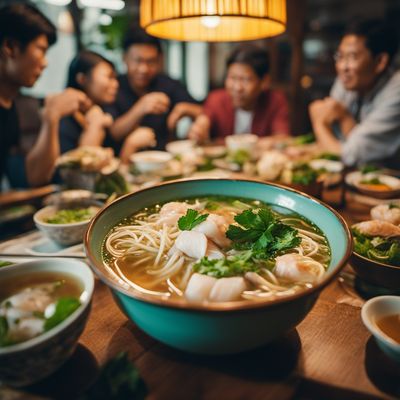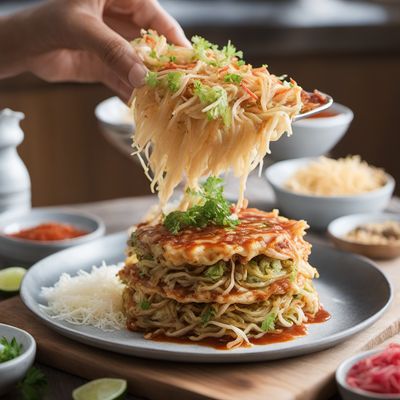
Recipe
Djiboutian-style Hủ tiếu Nam Vang
Savory Djiboutian Delight: Hủ tiếu Nam Vang with a Local Twist
4.6 out of 5
Indulge in the flavors of Djiboutian cuisine with this unique adaptation of the Vietnamese classic, Hủ tiếu Nam Vang. This dish combines the aromatic spices and vibrant ingredients of Djiboutian cuisine with the comforting and hearty qualities of the original Vietnamese recipe.
Metadata
Preparation time
20 minutes
Cooking time
20 minutes
Total time
40 minutes
Yields
4 servings
Preparation difficulty
Easy
Suitable for
Pescatarian, Dairy-free, Gluten-free, Nut-free, Low-fat
Allergens
Shellfish (shrimp)
Not suitable for
Vegan, Vegetarian, Paleo, Keto, High-protein
Ingredients
In this Djiboutian adaptation of Hủ tiếu Nam Vang, we incorporate traditional Djiboutian spices such as cumin, coriander, and turmeric to infuse the broth with a unique flavor profile. We also add local herbs and vegetables like lemongrass, mint, and okra to enhance the dish's freshness and bring a touch of Djiboutian culinary tradition to the recipe. We alse have the original recipe for Hủ tiếu Nam Vang, so you can check it out.
-
250g (8.8 oz) rice noodles 250g (8.8 oz) rice noodles
-
200g (7 oz) shrimp, peeled and deveined 200g (7 oz) shrimp, peeled and deveined
-
200g (7 oz) pork, thinly sliced 200g (7 oz) pork, thinly sliced
-
1 liter (4 cups) chicken or vegetable broth 1 liter (4 cups) chicken or vegetable broth
-
2 cloves garlic, minced 2 cloves garlic, minced
-
1 onion, thinly sliced 1 onion, thinly sliced
-
1 tablespoon Djiboutian spice blend (cumin, coriander, turmeric) 1 tablespoon Djiboutian spice blend (cumin, coriander, turmeric)
-
2 stalks lemongrass, bruised 2 stalks lemongrass, bruised
-
1 cup okra, sliced 1 cup okra, sliced
-
Handful of fresh mint leaves Handful of fresh mint leaves
-
Handful of fresh cilantro leaves Handful of fresh cilantro leaves
-
2 tablespoons vegetable oil 2 tablespoons vegetable oil
-
Salt and pepper to taste Salt and pepper to taste
-
Fried shallots and lime wedges for garnish Fried shallots and lime wedges for garnish
Nutrition
- Calories (kcal / KJ): 350 kcal / 1465 KJ
- Fat (total, saturated): 8g, 2g
- Carbohydrates (total, sugars): 45g, 3g
- Protein: 25g
- Fiber: 3g
- Salt: 2g
Preparation
-
1.Soak the rice noodles in cold water for 30 minutes, then drain and set aside.
-
2.In a large pot, heat the vegetable oil over medium heat. Add the minced garlic and sliced onion, and sauté until fragrant.
-
3.Add the pork slices to the pot and cook until browned.
-
4.Pour in the chicken or vegetable broth and bring to a simmer.
-
5.Add the Djiboutian spice blend, lemongrass, and sliced okra to the pot. Simmer for 10 minutes to allow the flavors to meld.
-
6.Add the shrimp to the pot and cook until they turn pink and opaque.
-
7.Season with salt and pepper to taste.
-
8.Divide the soaked rice noodles among serving bowls.
-
9.Ladle the hot broth, pork, shrimp, and vegetables over the noodles.
-
10.Garnish with fresh mint leaves, cilantro leaves, fried shallots, and a squeeze of lime juice.
-
11.Serve hot and enjoy!
Treat your ingredients with care...
- Rice noodles — Ensure that the rice noodles are soaked in cold water before cooking to achieve the desired texture. Do not overcook them as they can become mushy.
- Djiboutian spice blend — If you can't find a pre-made Djiboutian spice blend, you can create your own by combining equal parts cumin, coriander, and turmeric.
Tips & Tricks
- For a spicier kick, add a dash of Djiboutian chili powder or a few slices of fresh chili peppers to the broth.
- If you prefer a heartier version, you can add additional vegetables such as bok choy or bean sprouts.
- To make the dish more filling, serve it with a side of steamed Djiboutian bread or flatbread.
Serving advice
Serve Djiboutian-style Hủ tiếu Nam Vang hot in individual bowls, allowing each person to garnish their own bowl with fried shallots and lime wedges according to their taste preferences. Accompany the dish with a side of Djiboutian bread or flatbread for a complete meal.
Presentation advice
To enhance the presentation of Djiboutian-style Hủ tiếu Nam Vang, arrange the garnishes neatly on top of the noodles and broth. Sprinkle the fried shallots evenly and place a lime wedge on the side of each bowl. The vibrant colors of the fresh herbs and the crispy shallots will make the dish visually appealing.
More recipes...
For Hủ tiếu Nam Vang
For Vietnamese cuisine » Browse all

Refreshing Vietnamese Lime Beef Salad
Zesty Beef Delight: A Tangy Vietnamese Salad

Vietnamese-style Radicchio and Sausage Lasagne
Bánh Mì Lasagne: A Fusion of Italian and Vietnamese Flavors

Bánh ướt lòng gà (Steamed Rice Rolls with Chicken Offal)
Savory Delight: Steamed Rice Rolls with Chicken Offal
For Djiboutian cuisine » Browse all
More Vietnamese cuisine dishes » Browse all

Bánh rán
Banh ran
Bánh rán is a Vietnamese dish consisting of a deep-fried glutinous rice ball filled with sweet or savory ingredients.

Bún mắm Da Nang
Bun Mam Da Nang
Bún mắm Da Nang is a regional variation of bún mắm that originated in the city of Da Nang in Vietnam. It is known for its rich and complex flavor.

Phở hải sản
Seafood pho
Phở hải sản is a Vietnamese noodle soup made with seafood broth, rice noodles, and various herbs and spices. It is a popular dish in coastal...







